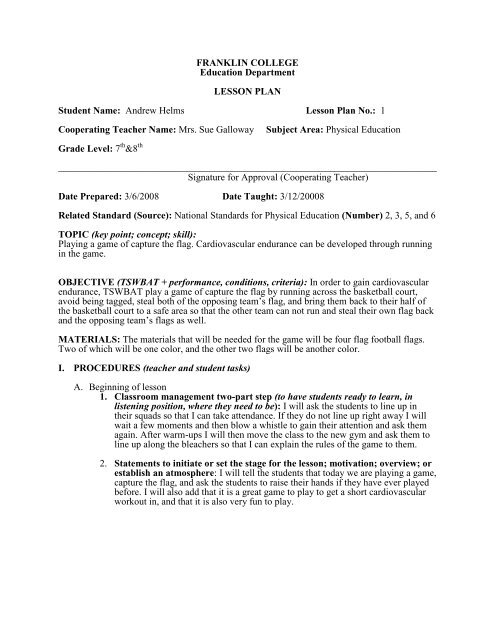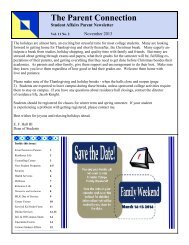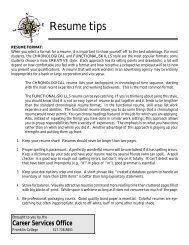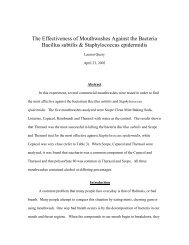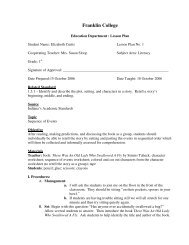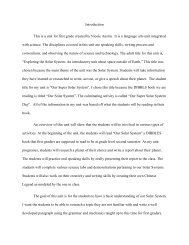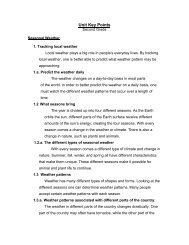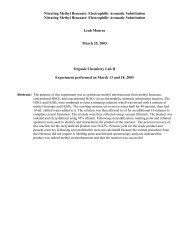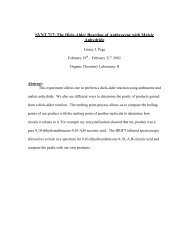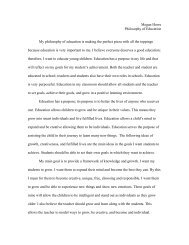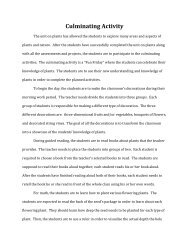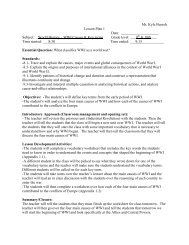Lesson Plans - Franklin College
Lesson Plans - Franklin College
Lesson Plans - Franklin College
Create successful ePaper yourself
Turn your PDF publications into a flip-book with our unique Google optimized e-Paper software.
FRANKLIN COLLEGE<br />
Education Department<br />
LESSON PLAN<br />
Student Name: Andrew Helms <strong>Lesson</strong> Plan No.: 1<br />
Cooperating Teacher Name: Mrs. Sue Galloway Subject Area: Physical Education<br />
Grade Level: 7 th &8 th<br />
______________________________________________________________________________<br />
Signature for Approval (Cooperating Teacher)<br />
Date Prepared: 3/6/2008 Date Taught: 3/12/20008<br />
Related Standard (Source): National Standards for Physical Education (Number) 2, 3, 5, and 6<br />
TOPIC (key point; concept; skill):<br />
Playing a game of capture the flag. Cardiovascular endurance can be developed through running<br />
in the game.<br />
OBJECTIVE (TSWBAT + performance, conditions, criteria): In order to gain cardiovascular<br />
endurance, TSWBAT play a game of capture the flag by running across the basketball court,<br />
avoid being tagged, steal both of the opposing team’s flag, and bring them back to their half of<br />
the basketball court to a safe area so that the other team can not run and steal their own flag back<br />
and the opposing team’s flags as well.<br />
MATERIALS: The materials that will be needed for the game will be four flag football flags.<br />
Two of which will be one color, and the other two flags will be another color.<br />
I. PROCEDURES (teacher and student tasks)<br />
A. Beginning of lesson<br />
1. Classroom management two-part step (to have students ready to learn, in<br />
listening position, where they need to be): I will ask the students to line up in<br />
their squads so that I can take attendance. If they do not line up right away I will<br />
wait a few moments and then blow a whistle to gain their attention and ask them<br />
again. After warm-ups I will then move the class to the new gym and ask them to<br />
line up along the bleachers so that I can explain the rules of the game to them.<br />
2. Statements to initiate or set the stage for the lesson; motivation; overview; or<br />
establish an atmosphere: I will tell the students that today we are playing a game,<br />
capture the flag, and ask the students to raise their hands if they have ever played<br />
before. I will also add that it is a great game to play to get a short cardiovascular<br />
workout in, and that it is also very fun to play.
B. Instruction Steps:<br />
*= Modifications (strategies to meet individual, special needs at a particular step)<br />
1. As the students enter the gym after changing I will instruct them to sit in their<br />
squads. Once all students are in the gym I will once again ask them to sit in their<br />
squads. If all of them do not do this the first time I ask, then I will blow my<br />
whistle then ask them again.<br />
2. Once all the students are seated in their squads I will take attendance by calling<br />
their last name and asking them to say “here” when they hear their name called.<br />
3. After attendance is taken, I will then stand at the front of the class and lead warmup<br />
stretches.<br />
4. Warm-ups will consist of ten(10) jumping jacks, stretching both arms across chest<br />
and behind the head, putting feet together and reaching for the toes, sit on the<br />
ground and do hurdler stretches for both legs, butterfly stretch, twenty(20)<br />
crunches, 10 push-ups, then finally having them run three (3) laps around the<br />
outside of the basketball court.<br />
5. When the students are done with their three laps, I will then tell them to go to the<br />
other gymnasium and line up next to the bleachers in there.<br />
6. Once all the students are in the other gymnasium and lined up next to the<br />
bleachers I will have them sit down on the floor and make a semi-circle in front of<br />
me.<br />
7. I will stand in front of the students and then proceed to explain to them the rules of<br />
Capture the Flag.<br />
8. The rules of capture the flag are very simple. I will ask the students to keep all<br />
questions until I am done explaining the rules of Capture the Flag.<br />
Rules: 1. I will split the class into two teams. Each team will have their own half<br />
of the basketball court.<br />
2. Each team will get two flags that are the same color. You will place the<br />
flags on the corners of the basketball where the sideline meets the<br />
baseline.<br />
* if the students do not know where this is at I will walk to that spot<br />
and show them.<br />
3.You are allowed to guard the flags, but only one person per flag. That<br />
person must stand at least 5 ft. away from the flag. You can not stand<br />
directly on top of the flag.<br />
4. To steal the opposing team’s flag players from you team must run across<br />
the half court line, grab the flag, and bring it back to your half the<br />
basketball court. Then place their flag next to one of your own flags. If<br />
you get tagged while trying to steal the flag you must go to jail. The jail<br />
is the rectangular box that makes the free throw lanes and free throw<br />
lines on the basketball court.<br />
*if the students are not sure of where the jail is at, I will walk out onto<br />
the court and show them.
5. If you are to get tagged while bringing the flag back to your side of the<br />
court, you must go to jail and drop the flag at the spot where you were<br />
tagged at.<br />
* show an example of this if needed<br />
6. To get out of jail one of your teammates must run across the court and<br />
tag you, then you are free to go back and continue to play the game.<br />
7. If one of your flags is stolen then you are able to steal it back from the<br />
other team.<br />
8. The winner is finally determined once one of the teams steals both of<br />
the opposing team’s flags and them back to their side of the basketball<br />
court.<br />
9. Unless you are guarding the flag you must be moving at all times. If I<br />
catch you standing around I will give a warning. If I have to tell you a<br />
second time to move you will lose your participation for the day and<br />
will run laps for the rest of class period.<br />
9. Once I have explained all the rules to the students, I will then ask if anyone has<br />
any questions.<br />
10. After all questions are answered, if I were to assign homework I would do so now.<br />
Since I am not I will then split the class into two teams.<br />
11. When I choose teams I will give each student a number, 1 or 2, and have the 1’s<br />
go to one side of the half court line and 2’s go to the opposite side. When I give<br />
them their number it will be random. I will not just go by the way they are sitting<br />
on the floor. I will just point to random students and give them a number.<br />
*if special needs students are in class I will split them up evenly on each team.<br />
12. I will then give each team their flags and tell them to place their flags at the<br />
appropriate spots on the basketball court, the corner where the baseline and<br />
sideline meet.<br />
13. I will then tell each team to stand on the line underneath the basketball court and<br />
to get ready. I will then move out of the way and stand near the bleachers.<br />
14. I will then ask each team if they are ready, and blow my whistle to start the game.<br />
15. Once the game has begun, I will make sure that all the students are actively<br />
participating, and if need be I will change rules if things become too complicated<br />
or confusing for them.<br />
C. Closure statement (brief lesson review, summary; does not have to be the last step if<br />
something is going to be made or an activity will follow): When it is time for the<br />
students to go and get dressed and leave I will end the game and ask the students to<br />
check their pulse. Since they have been running and this is a cardio workout, I will<br />
hope that they will have a decent heart rate. Once they checked their pulse I will<br />
dismiss them.
II. ASSESSMENT (how is objective met by students: observation, written work,<br />
presentations, quiz, etc.): All students will be assessed during the game of Capture the<br />
Flag through teacher observation. As long as the students keep moving and participate<br />
actively they will receive all of their participation points for the day. If they do not<br />
participate then they will run laps for the class period.<br />
III. EXTENSION AND REMEDIATION (what will be done beyond lesson; strategies for<br />
those who need further<br />
instruction, assistance): Extensions for this game for the entire class would be that I<br />
would add dodge balls to the game so that the students could tag one another with the<br />
balls rather than just running and tagging them with their hands. An extension for an<br />
individual student would be to have that student develop multiple strategies to try and<br />
steal the flag. Remediation for the entire class would be to just split the class into four<br />
teams instead of two so that the teams are smaller and it would make the game a little<br />
easier to play. Remediation for an individual student would be to just have them be a<br />
person who guards the flag. If they are having a really hard time trying to running and<br />
they keep getting tagged, then I will have them just guard the flag so that they will not<br />
have to move around too much.<br />
IV. HOMEWORK ASSIGNMENT(S): There will be no homework assigned for this lesson.<br />
If homework were to be given for this lesson plan I would have the students write a short<br />
half a page to one page essay on why cardiovascular endurance is important. If I had a<br />
student that happens to be in I.S.S. at the time of my class, I would assign that student<br />
that same lesson to do during their time in In School Suspension.
FRANKLIN COLLEGE<br />
Education Department<br />
LESSON PLAN<br />
Student Name: Andrew Helms <strong>Lesson</strong> Plan No. 1<br />
Cooperating Teacher: Mr. Gorrell Subject Area: Physical Education Grade Level: 5 th and 6 th grade<br />
______________________________________________________________________________________<br />
Signature for Approval (Cooperating Teacher)<br />
Date Prepared: 10-3-2009 Date Taught: 10-7-2009<br />
Related Standard (Source): National Standards for Physical Education<br />
Standard 2: Demonstrates an understanding of movement concepts, principals, strategies, and tactics as they apply to<br />
the learning and performance of physical activities.<br />
Standard 5: Exhibits responsible personal and social behavior that respects self and others in physical activity<br />
settings.<br />
Standard 6: Values physical activity for health, enjoyment, challenge, self-expression, and/or social interaction.<br />
TOPIC (key point; concept; skill): Four Square<br />
OBJECTIVE (TSWBAT + performance, conditions, criteria): The student will be able to play a game of four<br />
square by tossing a ball into an opponent’s square so that the person can not return the ball, therefore knocking that<br />
player out of the game and moving them to the end of the line, and the winner of the game will be determined by<br />
who holds the top square at the end of the class.<br />
MATERIALS: Playground balls<br />
I. PROCEDURES (teacher and student tasks)<br />
A. Beginning of lesson<br />
Classroom management two-part step (to have students ready to learn, in listening position, where they need to be):<br />
The students will get dressed and will sit in their squads in the gym. They should be sitting quietly, and if they are<br />
talking I will blow my whistle. If they are still talking I will remind them that they are wasting their P.E. time and<br />
that if they want to get into the activities they need to be quiet and listen.<br />
2. Statements to initiate or set the stage for the lesson; motivation; overview; or establish an atmosphere: I<br />
will first ask if anyone has ever played four square before. Then I will say that four square is a great game that can<br />
be played during recess or even after school with your friends.<br />
B. Instruction Steps:<br />
*= Modifications (strategies to meet individual, special needs at a particular step)<br />
1. To start the lesson I will move the students to the area of the gym where the four square courts at and<br />
have them sit on the blue sideline.<br />
2. Once they are there I will describe the rules of four square to them. The rules are as follows:<br />
Normal game play:<br />
The player in the highest rank, called four square or 'royalty,' serves the ball into the lowest ranking square, called<br />
one square. After a single bounce in one square, the player must hit the ball (return) into any other legal square<br />
before it bounces again. Each time the ball is bounced in any square, that player must hit it into any other player's
square (return) to stay in the game. The game continues until a player makes an error by letting the ball bounce<br />
twice, or hitting the ball out of bounds.<br />
During game play, players must hit or touch the ball with enough force to create a change in the ball's path and<br />
trajectory that is perceptible to the officials. Hits that do not change the path or trajectory of the ball will cause the<br />
offending player to be out.<br />
Serving the Ball:<br />
The ball is always served from four square into one square. The serve is always delivered from the back corner of<br />
the square, sometimes called the 'mailbox.' Four square must call any custom rules first, drop the ball and serve from<br />
the bounce. Serves are meant to place the ball fairly into play and must be returnable by the player in square one,<br />
generally taking its first bounce near the center of square one.<br />
3.While describing the rules, I will be demonstrating them as well on the four square courts. I will also use a couple<br />
students that may have played the game before help me with the demonstrations.<br />
4.When a student is knocked out they will go to the back of the line and wait until they are back into the game.<br />
Players will keep rotating in during the game as people are eliminated.<br />
Closure statement (brief lesson review, summary; does not have to be the last step if something is going to be made<br />
or an activity will follow): Four square can be a very fun but hard game, but as you can see with a little practice can<br />
be competitive and enjoyable for you and all your friends.<br />
II. ASSESSMENT (how is objective met by students: observation, written work, presentations, quiz, etc.): I<br />
will be assessing the students through observation. The students will meet their objectives by staying involved in<br />
class and paying attention to me when I am speaking to them.<br />
EXTENSION (what will be done beyond lesson): Using a smaller ball (tennis ball) to make the game a little more<br />
complicated to play. This would also increase some hand eye coordination as well.<br />
REMEDIATION (strategies for those who need further instruction, assistance): Using a larger ball so that it<br />
would be easier for the students to play the game. For individual students that are having trouble I would place them<br />
together so that they would be playing with people within their own skill level.<br />
V. HOMEWORK ASSIGNMENT(S): No homework
FRANKLIN COLLEGE<br />
Education Department<br />
LESSON PLAN<br />
Student Name: Andrew Helms <strong>Lesson</strong> Plan No. 1<br />
Cooperating Teacher: Mr. Grace Subject Area: Physical Education Grade Level: High School<br />
______________________________________________________________________________________<br />
Signature for Approval (Cooperating Teacher)<br />
Date Prepared: 3-20-2009 Date Taught: 3-25-2009<br />
Related Standard (Source): Indiana Standards for Physical Education<br />
Standard 3- Exhibits a physically active lifestyle.<br />
Standard 4- Achieves and maintains a health-enhancing level of physical fitness.<br />
TOPIC (key point; concept; skill): Agility, abdominal, and cardio workout<br />
OBJECTIVE (TSWBAT + performance, conditions, criteria): The student will be able to improve their foot work,<br />
abdominal strength, and cardiovascular endurance by performing a series of footwork drills, abdominal workouts,<br />
and running laps around the gym for a set amount of time for each workout.<br />
MATERIALS: None<br />
I. PROCEDURES (teacher and student tasks)<br />
A. Beginning of lesson<br />
2. Classroom management two-part step (to have students ready to learn, in listening position, where<br />
they need to be): The students will meet in the weight room and change into their P.E. cloths. Once<br />
they are changed and ready, we will go to the second floor gymnasium. I will have them line up on<br />
the baseline of the basketball court and prepare for stretches. If they do not do this the first time, I<br />
will blow my whistle to gain their attention and ask them to line up again.<br />
2. Statements to initiate or set the stage for the lesson; motivation; overview; or establish an<br />
atmosphere: I will tell the students that today they will be doing a couple agility drills along with<br />
some abdominal exercises. They will finish up the class with some running as well.<br />
B. Instruction Steps:<br />
*= Modifications (strategies to meet individual, special needs at a particular step)<br />
1. The students will begin class by running five laps around the outside of the basketball court.<br />
2. Once the laps are completed the students will line up on the baseline and do their warm-up exercises.<br />
a. High knees to half court<br />
b. Butt kicks back to baseline<br />
c. Forward lunge to half court, and forward lunge back to baseline.<br />
d. Karaoke to half court, karaoke back to baseline<br />
e. Jog down to opposite baseline and jog back.<br />
3. After warm-ups students will do a few stretches.<br />
a. Touch Toes<br />
b. Cross right/left legs and touch toes
c. Straddle legs and touch each foot<br />
d. Stretch calves<br />
e. Stretch left and right quadriceps<br />
4. When stretches are complete we will go into the agility drills. These drills are the “four square” drills<br />
where the students will hop in a particular patter either with two feet or one foot for a set amount of<br />
time.<br />
Four Square Pattern: Sets: Time:<br />
Both Feet 1-2 2 20s<br />
1-4 2 20s<br />
1-2-3 2 20s<br />
1-3-2 2 20s<br />
1-2-3-4 2 20s<br />
4-3-2-1 2 20s<br />
Single Leg 1-2 2 10s<br />
1-4 2 10s<br />
1-3 2 10s<br />
4-2 2 10s<br />
5. Once the footwork drills are completed, I will move the students to the wrestling mat where they will<br />
do a few abdominal exercises. I will do five different exercises, and they will be given a certain time<br />
limit to try and complete as many repetitions as they can.<br />
a. Regular crunch (45s)<br />
b. Lift legs up, touch toes (45s)<br />
c. Plank (30s)<br />
Stretch abs<br />
d. Butterfly crunch (45s)<br />
e. Lift legs up, side to side (45s)<br />
Stretch abs<br />
6. After the abdominal exercises are completed the students will run three laps around the entire<br />
gymnasium and then do the same stretches that they did earlier. They will do the toe touches,<br />
quadriceps stretch, calve stretch etc…<br />
D. Closure statement (brief lesson review, summary; does not have to be the last step if something is going<br />
to be made or an activity will follow): After the students are finished stretching I will tell them good job<br />
and then they will go back downstairs to the weight room and change.<br />
II. ASSESSMENT (how is objective met by students: observation, written work, presentations, quiz, etc.):<br />
The objective is being met by just simply performing the workout during the set time. The students should be<br />
trying their best not to stop before I tell them time is up, and they should be doing the exercise all the way<br />
through the whole time span. As long as they are trying and doing the workout to their best abilities, the<br />
objective will be met.<br />
V. EXTENSION (what will be done beyond lesson): To extend this lesson I would add more time to each<br />
exercise so that they students would have to perform the workout for a longer period of time. To extend this<br />
for a particular individual I could have them hold a weight while doing the crunches to make them more<br />
difficult.<br />
2<br />
1<br />
3<br />
4
VI. REMEDIATION (strategies for those who need further instruction, assistance): To help the students who<br />
are having trouble or difficulty I would lower the time limits for the exercises. For individuals I could just<br />
lower their time limit or have them do a different type of exercise<br />
V. HOMEWORK ASSIGNMENT(S): No homework


